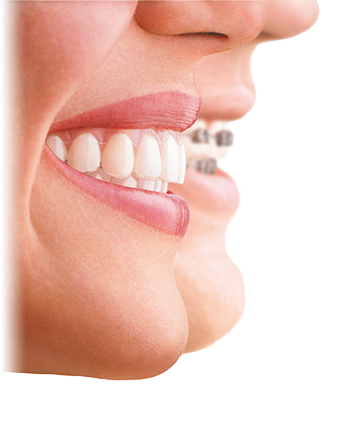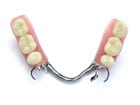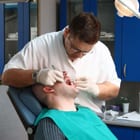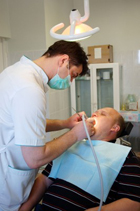 Some of the most common dental injuries occur when patients crack or break a tooth. This often happens while undertaking physical activity or can be the result of a head trauma, such as a car crash. Apart from being painful, these types of dental injury can also need complex cosmetic dental procedures to fix them. With cracks and breaks, dental bonding and fillings are sometimes insufficient, especially if the injury is quite severe, and in these instances a dental crown is the only option to save the tooth.
Some of the most common dental injuries occur when patients crack or break a tooth. This often happens while undertaking physical activity or can be the result of a head trauma, such as a car crash. Apart from being painful, these types of dental injury can also need complex cosmetic dental procedures to fix them. With cracks and breaks, dental bonding and fillings are sometimes insufficient, especially if the injury is quite severe, and in these instances a dental crown is the only option to save the tooth.
Dental crowns, or caps as they are sometimes known, can also be used to repair extensive damage to teeth caused by tooth decay. If the tooth has decayed to the point that it cannot support a filling, then it will need to crowned to protect it from further damage and ultimately tooth loss. Crowns are also used after root canal procedures when they are cemented in place to prevent any further infection and to restore the appearance of a natural tooth.
Before resorting to a crown, the dentist will always explore all the other possible avenues. This is because to apply a crown, a dentist will need to grind down the existing tooth to make it small enough to receive a crown and the adhesive cement. Once the tooth has been ground, it cannot repair itself and a crown must be worn there for life. Dentists use crowns when there is no other alternative and the integrity of the tooth has been damaged so badly as to leave no other option.
Various materials are used in the manufacture of crowns. They are usually made from porcelain, a form of ceramic, or alternatively a porcelain-metal alloy. These give the most realistic appearance and can be made from porcelain selected specifically to match the existing teeth of the patient. However, for the more extroverted, there is the option to have a crown made of gold or silver.
When fitting a crown, a dentist will first take a mould and x-ray of the patient’s teeth. Then using the very latest in 3D computer technology, they can produce an image of the teeth on a computer. This allows the manufacturing process to be incredibly accurate and means the crown can be designed to fit perfectly over the damaged tooth. If looked after correctly, with appropriate brushing and flossing, a crown can last between ten and fifteen years. Visit a Leeds dentist if you have a damaged or decayed tooth and would like to restore its natural appearance.





 For patients suffering from a missing tooth or teeth, one cosmetic procedure that can restore the appearance of a full set is a dental bridge. By bonding a dental bridge to existing teeth either side of the gap, a dentist can create a natural looking and seamless artificial bridge.
For patients suffering from a missing tooth or teeth, one cosmetic procedure that can restore the appearance of a full set is a dental bridge. By bonding a dental bridge to existing teeth either side of the gap, a dentist can create a natural looking and seamless artificial bridge. A lot has been written about dental amalgam fillings over the past few years and it is difficult to ascertain what is true and what is simply scaremongering. Dental amalgam fillings are strong and durable alloy fillings, usually comprised of a mix of 46 to 57 per cent silver and 43 to 54 per cent liquid mercury. Amalgam fillings, often referred to as silver fillings, were invented in France in the 1800s and have been used all over the world to fill cavities in patients teeth. In more recent years, amalgam fillings have been replaced in many areas by composite resin fillings. These resin filings have the advantage of being tooth coloured and therefore don’t stand out as much as silver fillings.
A lot has been written about dental amalgam fillings over the past few years and it is difficult to ascertain what is true and what is simply scaremongering. Dental amalgam fillings are strong and durable alloy fillings, usually comprised of a mix of 46 to 57 per cent silver and 43 to 54 per cent liquid mercury. Amalgam fillings, often referred to as silver fillings, were invented in France in the 1800s and have been used all over the world to fill cavities in patients teeth. In more recent years, amalgam fillings have been replaced in many areas by composite resin fillings. These resin filings have the advantage of being tooth coloured and therefore don’t stand out as much as silver fillings. Are you frustrated or embarrassed by a small defect or flaw in your teeth such as a chip or crack? If you suffer from minor but still visible faults in your teeth such as grooves, worn edges or overlapping then you might be able to save your smile using a process called tooth contouring.
Are you frustrated or embarrassed by a small defect or flaw in your teeth such as a chip or crack? If you suffer from minor but still visible faults in your teeth such as grooves, worn edges or overlapping then you might be able to save your smile using a process called tooth contouring. Until the advent of composite resin fillings, or white fillings as they are more commonly known, patients had little choice but to have unseemly amalgam fillings. These amalgam fillings, invented in France in the early 1800s, had been widely used around the world to fill dental cavities. Made form an alloy of silver and mercury, these amalgam fillings, while very strong, were very noticeable in the mouth. They also expanded over time causing further damage to teeth and were notoriously difficult to fit, with dentists often having to inflict unnecessary damage on teeth to fix them. More concerning is the controversy that surrounds amalgam fillings with regards poisonous and dangerous mercury vapours that are released into the body when placed and during eating. Although this has never been resolutely confirmed it is enough of a concern to many patients to want to have them replaced.
Until the advent of composite resin fillings, or white fillings as they are more commonly known, patients had little choice but to have unseemly amalgam fillings. These amalgam fillings, invented in France in the early 1800s, had been widely used around the world to fill dental cavities. Made form an alloy of silver and mercury, these amalgam fillings, while very strong, were very noticeable in the mouth. They also expanded over time causing further damage to teeth and were notoriously difficult to fit, with dentists often having to inflict unnecessary damage on teeth to fix them. More concerning is the controversy that surrounds amalgam fillings with regards poisonous and dangerous mercury vapours that are released into the body when placed and during eating. Although this has never been resolutely confirmed it is enough of a concern to many patients to want to have them replaced. Orthodontics is a branch of dentistry that is specifically focused on correcting problems that arise due to malocculsion, more commonly known as bite. Efforts to correct these problems go back to 1000 years BC and orthodontic materials have been found of both ancient Egyptian and Etruscan origin. Historically, orthodontics was primarily concerned with restorative or medical conditions associated with the jaw and bite but more recently it has increasingly been used for more aesthetic or cosmetic reasons.
Orthodontics is a branch of dentistry that is specifically focused on correcting problems that arise due to malocculsion, more commonly known as bite. Efforts to correct these problems go back to 1000 years BC and orthodontic materials have been found of both ancient Egyptian and Etruscan origin. Historically, orthodontics was primarily concerned with restorative or medical conditions associated with the jaw and bite but more recently it has increasingly been used for more aesthetic or cosmetic reasons. Dentistry has made enormous strides in the last twenty years, both in terms of technology and treatment. The intimidating surgeries of the past are no more and today dental surgeries resemble health spas more than hospitals. Technological advances have also greatly improved the accuracy and speed of treatment and none more so than the advent of CEREC technology. CEREC stands for Ceramic REConstruction and is a new tool that allows dentists to measure, design, fabricate and install a new crown all in one visit. Using the old methods of laboratory manufacture, a new crown would take several weeks and multiple visits to the dentist.
Dentistry has made enormous strides in the last twenty years, both in terms of technology and treatment. The intimidating surgeries of the past are no more and today dental surgeries resemble health spas more than hospitals. Technological advances have also greatly improved the accuracy and speed of treatment and none more so than the advent of CEREC technology. CEREC stands for Ceramic REConstruction and is a new tool that allows dentists to measure, design, fabricate and install a new crown all in one visit. Using the old methods of laboratory manufacture, a new crown would take several weeks and multiple visits to the dentist. Teeth can often become stained over the course of the years, either due to lifestyle choices like smoking, drinking red wine and coffee or simply as part of the aging process. Yellow or brown stained teeth can appear very unattractive and can be the source of considerable embarrassment that will stop you smiling.
Teeth can often become stained over the course of the years, either due to lifestyle choices like smoking, drinking red wine and coffee or simply as part of the aging process. Yellow or brown stained teeth can appear very unattractive and can be the source of considerable embarrassment that will stop you smiling. When a tooth becomes infected in its root, it becomes necessary to remove the root in order to save the tooth and prevent the spread of infection. This process is called a root canal treatment and involves completely removing the infected pulp at the centre of the tooth that may be causing severe pain and greatly affecting your dental and general health. Occasionally a root canal can be used to treat a tooth abscess where the abscess is a result of a greater infection.
When a tooth becomes infected in its root, it becomes necessary to remove the root in order to save the tooth and prevent the spread of infection. This process is called a root canal treatment and involves completely removing the infected pulp at the centre of the tooth that may be causing severe pain and greatly affecting your dental and general health. Occasionally a root canal can be used to treat a tooth abscess where the abscess is a result of a greater infection. Over 90 per cent of us confess to having a fear of the dentist. For most of that 90 per cent the fear is mild and easily overcome by the knowledge that looking after your teeth is more important. For others who suffer from a more severe dental phobia the fear wins and their oral health suffers as a result. Many nervous or anxious patients suffer from gum disease and tooth decay because they put off or avoid coming to the dentist for check ups. Regular dental check ups are one of the best ways to avoid problems such as these so in some respects their fears are making the situation worse.
Over 90 per cent of us confess to having a fear of the dentist. For most of that 90 per cent the fear is mild and easily overcome by the knowledge that looking after your teeth is more important. For others who suffer from a more severe dental phobia the fear wins and their oral health suffers as a result. Many nervous or anxious patients suffer from gum disease and tooth decay because they put off or avoid coming to the dentist for check ups. Regular dental check ups are one of the best ways to avoid problems such as these so in some respects their fears are making the situation worse.

